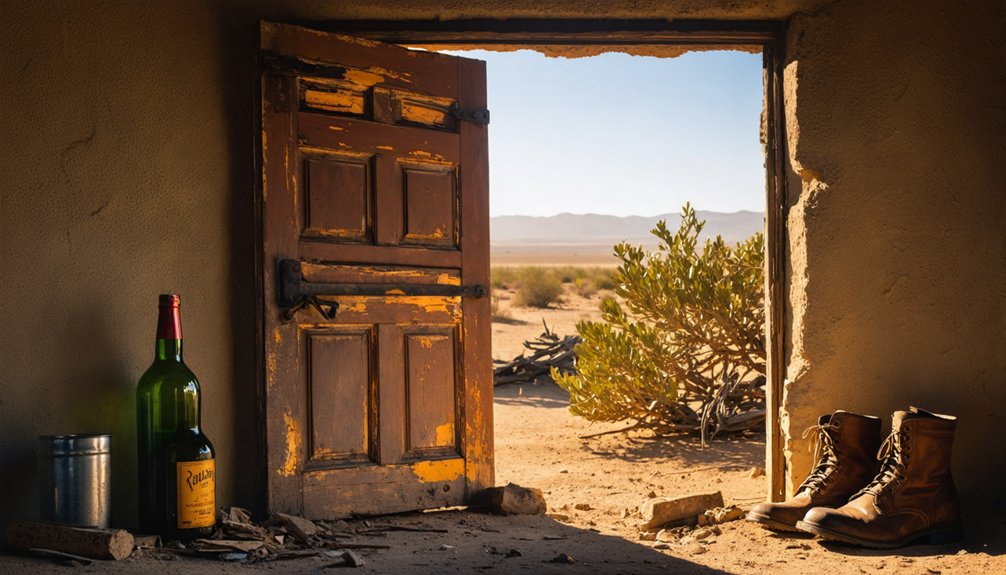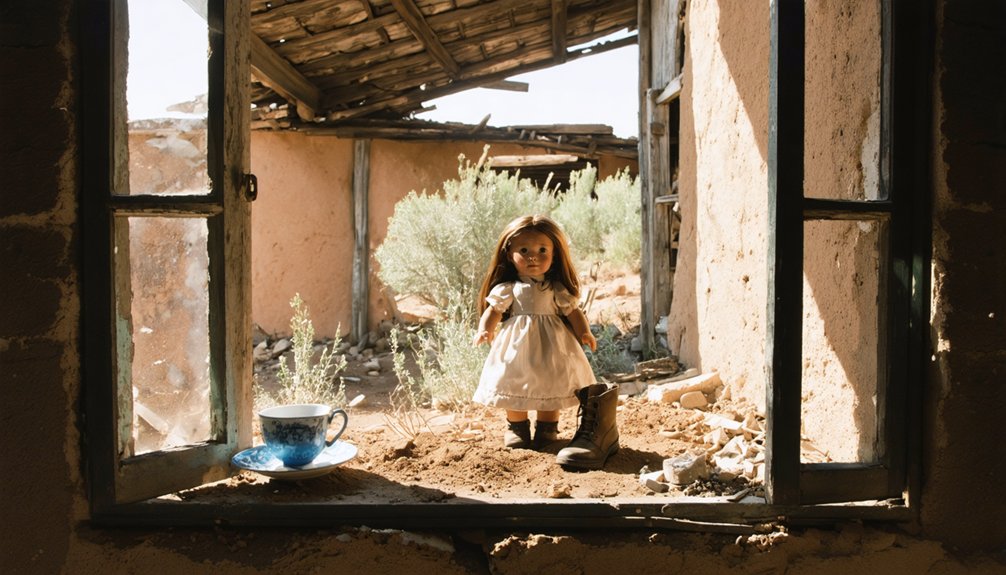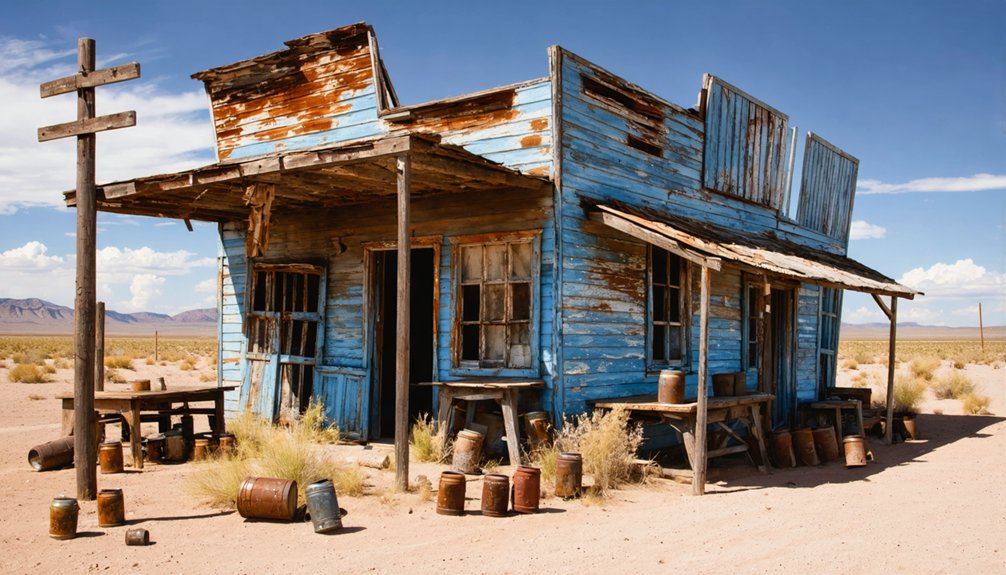Piedmont, Arizona emerged as a strategic railroad outpost in the late 19th century between the Weaver and Date Creek Mountains. You’ll discover this ghost town thrived during Arizona’s gold mining boom, with its economy and social life revolving around railroad operations until early 20th century tunnel construction rerouted train traffic. Today, you can explore crumbling foundations, rusting ore carts, and weathered headstones that silently chronicle Arizona’s mining and transportation evolution in this authentic forgotten settlement.
Key Takeaways
- Piedmont was established in the late 19th century as a strategic railroad outpost and gold mining district in Yavapai County.
- Located at 3,540 feet elevation between Weaver and Date Creek Mountains, the town thrived during the mining boom era (1890-1917).
- The community’s social life centered around railroad operations, with commissaries and saloons serving as gathering spaces for workers.
- Rail traffic ceased in the early 20th century when a northern tunnel rerouted trains, leading to Piedmont’s economic collapse.
- Visitors today can explore crumbling stone foundations, rusting ore carts, fragmented rail tracks, and a weathered cemetery.
The Rise of a Railroad Outpost Between Mountains
Nestled between Arizona’s formidable mountain ranges, Piedmont emerged in the late 19th century as a critical railroad outpost that would briefly flourish as a transportation nexus. Its strategic location formed a natural corridor connecting key mining districts to larger Arizona hubs like Prescott and Benson.
The rugged terrain surrounding Piedmont presented immense railroad engineering challenges. Narrow gauge tracks with sharp curves and grades up to 3% navigated the difficult topography, requiring extensive earthworks, bridges, and switchbacks. These transportation routes were considered among the most challenging in the country, yet they successfully linked remote mineral-rich areas to broader rail networks. The construction crews, primarily consisting of Native Americans, Mexicans, and Mormons, worked tirelessly to lay more than a mile of track daily despite the difficult conditions. The first locomotive to traverse Arizona’s rails was Engine No. 31, marking a historic milestone in the territory’s development.
You’ll find Piedmont’s significance lay in its junction role—where stagecoaches, freight wagons, and trains converged, enabling essential economic connections between isolated mining camps and established markets.
Mining Boom: Piedmont’s Golden Era
As Arizona’s territorial aspirations expanded in the late 19th century, Piedmont established itself as one of Yavapai County’s most promising gold mining districts at an elevation of 3,540 feet.
Between 1890 and 1917, you’d have witnessed the transformation from basic placer operations to sophisticated hard-rock gold extraction methods that defined the town’s prosperity.
The boom coincided with technological advances that revolutionized mining throughout central Arizona. Mechanized tools, explosives, and small locomotives enabled miners to extract previously inaccessible low-grade ores.
You’d have seen shafts and tunnels replacing rudimentary techniques as mining technology evolved rapidly during this industrialization era. The area’s growth mirrored similar developments in the Bradshaw Mountains where significant gold discoveries fueled regional mining expansion.
Piedmont miners faced many of the same constant dangers as other mining camps, including disease, floods, fires, and injuries that threatened their livelihood and survival.
Though specific production figures remain scarce, Piedmont’s contributions to Arizona’s reputation as a leading southwestern gold producer were substantial, creating jobs and driving economic growth throughout Yavapai County.
Life Along the Tracks: Daily Existence in Piedmont
As you walk Piedmont’s abandoned main street, you’ll notice how completely the town’s social geography revolved around railroad operations, with workers’ routines structured entirely by train schedules and maintenance demands.
The commissary and makeshift saloons served as essential gathering spaces where laborers exchanged news, formed community bonds, and briefly escaped the isolation of frontier railroad work. Like many Arizona ghost towns, Piedmont’s community hub flourished around its post office, which served as both a communication lifeline and symbol of the settlement’s legitimacy.
Your exploration reveals how residents’ daily existence reflected the transient rhythm of railroad life—constantly adapting to operational changes while maintaining the commercial infrastructure needed to support a workforce perpetually in motion. The impressive charcoal kilns that resemble large beehives stand as remnants of what was once a significant industry sustaining the town’s economy.
Railroad Workers’ Routines
The dawn’s first light typically found railroad workers already at their posts along the Piedmont tracks, beginning another day of grueling physical labor that would stretch from sunrise to sunset.
Their work routines followed the rhythms of railroad construction: grading land, laying track, and driving spikes with methodical precision.
Chinese veterans of the transcontinental railroad tackled Piedmont’s most challenging terrain—swamps and steep grades near Cienega Creek.
Labor challenges intensified under Arizona’s merciless sun, with crews moving forward in specialized roles as graders, gandy dancers, and pike drivers.
You’d find workers living in mobile bunkhouses that followed the advancing railhead, cooking simple meals between shifts.
While white laborers earned slightly more than their Chinese counterparts ($31-$35 monthly), all shared the monotonous yet essential task of forging steel pathways through the wilderness.
The construction was remarkably efficient, reducing what once took months to just a few days of travel time across the region.
The completion of these railroad lines effectively ended the Indian Wars by allowing rapid deployment of Army troops throughout the territory.
Social Gathering Spaces
Social gathering spaces in Piedmont thrived alongside the railroad tracks, forming the heart of this transient community’s daily existence. The town’s small saloon became central to Piedmont’s saloon culture, where railroad workers unwound after shifts, sharing tales of the line while sipping whiskey and playing cards.
Unlike larger mining settlements, Piedmont’s general store doubled as a community hub, with its bulletin board announcing arrivals, departures, and job opportunities. Residents often swapped stories about nearby ghost towns too tough to die, like Tombstone with its famous O.K. Corral gunfight. Similar to Vulture City, which was founded in 1863 by a prospector, these tales captured the imagination of locals.
Community connections formed at the modest outdoor gathering area near the station platform, where impromptu celebrations marked holidays and railway milestones.
Though lacking formal civic buildings, Piedmont residents congregated under the desert sky for occasional religious services conducted by traveling preachers. The rhythm of arriving and departing trains structured these social interactions, reinforcing the settlement’s identity as a place of temporary but meaningful human connection.
When the Trains Stopped: Beginning of the End
When rail traffic through Piedmont ceased in the early 20th century, the town’s fate was effectively sealed. The completion of a northern tunnel rerouted trains away from the settlement, severing Piedmont’s economic lifeline overnight. This railroad shift eliminated the steady flow of workers, passengers, and commerce that had sustained the community since its founding.
You can trace the town’s collapse directly to its extreme economic reliance on the Atchison, Topeka and Santa Fe Railway. Businesses that served railroad employees quickly shuttered, supply chains crumbled, and residents departed in search of new opportunities.
The abandoned infrastructure—wooden ties, charcoal kilns, and station buildings—deteriorated rapidly without maintenance. Like many similar settlements across Arizona, Piedmont demonstrates how vulnerable single-industry towns become when transportation networks evolve, leaving behind only scattered ruins and forgotten stories.
What Remains: Exploring Piedmont’s Ruins Today

Visitors to Piedmont today encounter a haunting tableau of crumbling stone foundations and weathered ruins scattered across the arid Arizona landscape. Your ruins exploration reveals the skeleton of a once-thriving mining community—visible stone outlines mark former buildings, while rusting ore carts and fragmented rail tracks hint at industrial vigor.
The cemetery’s weathered headstones stand as silent sentinels to Piedmont’s past, offering glimpses of historical significance amid the decay.
You’ll find remnants of the Piedmont Mine, including partial mill foundations and collapsed tunnels. Desert elements continually reclaim these structures; erosion and sand gradually erase what human abandonment began.
Unlike some restored ghost towns nearby, Piedmont remains largely untouched, its degrading artifacts and foundations telling an unfiltered story of boom-and-bust Arizona mining history.
The Geography That Shaped Piedmont’s Destiny
As you approach the remains of Piedmont, you’ll notice how the town strategically occupied a natural passage where mountains yielded to the pathway of the railroad.
The geographic positioning wasn’t accidental—Piedmont’s founders recognized how this meeting point of elevated terrain and accessible transportation routes would facilitate the movement of mining resources to distant markets.
This convergence of natural topography and human engineering ultimately determined both Piedmont’s rapid rise as a mining center and its eventual abandonment when the geographic advantages no longer outweighed economic challenges.
Mountains Meet Railroad
Three geographical factors converged to determine Piedmont’s brief but significant existence: mountain terrain, railroad engineering, and regional connectivity needs.
You’ll find Piedmont situated precisely where the Basin and Range province intersects vital rail corridors, creating a natural conduit through otherwise challenging topography.
When Southern Pacific expanded eastward from Tucson in 1880, railroad engineering teams confronted geographical obstacles that demanded strategic solutions. They selected routes following natural valleys and gaps, minimizing steep grades while maintaining operational viability.
The surrounding low mountain ranges funneled construction through specific corridors, making Piedmont’s location indispensable for connecting southeastern Arizona to New Mexico and beyond.
This geographical intersection transformed Piedmont into a key node within the transcontinental system, integrating Arizona’s resources into national economic networks despite the challenging mountain landscape.
Nature’s Strategic Passage
Nestled between the rugged Weaver Mountains and the Date Creek Mountains, Piedmont’s geographical position carved its unique destiny in Arizona’s historical landscape.
You’ll find that these natural corridors functionally determined how humans interacted with this challenging environment, creating predictable pathways through otherwise impenetrable terrain.
As you explore the area around 34.23° N latitude, you’ll notice how these mountain passes dictated the Atchison Topeka and Santa Fe Railroad’s route and influenced Date Creek Road‘s path.
The rugged terrain channeled economic activities, particularly mining operations, by providing essential transportation routes for copper ore and supplies.
This strategic geography turned Piedmont into a significant logistical node within Arizona’s mining network, yet ultimately contributed to its ghost town status once those economic activities ceased.
Forgotten Stories: The People Who Called Piedmont Home

Behind the weathered facades and crumbling foundations of Piedmont lie the untold stories of ordinary people who once called this mining settlement home.
Pioneer families established a resilient community amidst the challenging terrain between Weaver and Date Creek Mountains. You’ll find their legacy etched into the landscape they transformed through mining hardships and frontier determination.
Against all odds, frontier families carved hope from harsh wilderness, their spirit surviving in each stone and shadow.
- Miners and their families formed the backbone of Piedmont’s modest population.
- Immigrant laborers brought diverse cultural influences to this isolated outpost.
- Boarding houses served as communal hubs where workers shared stories and support.
- Children attended basic schools while adapting to the harsh Arizona environment.
- Daily life revolved around mining shifts, with economic prosperity and hardship following the boom-and-bust cycle.
Visiting Piedmont: A Modern Explorer’s Guide
Journeying to Piedmont today offers more of a historical pilgrimage than a traditional ghost town experience.
Located between the Weaver and Date Creek Mountains in Yavapai County, you’ll find little more than a solitary sign beside the former Atchison Topeka & Santa Fe Railroad line—a humble monument to Arizona’s railroad history.
Accessible via 2WD vehicles on Date Creek Road (Route 62), this site requires GPS navigation as official signage is minimal.
Plan your ghost town exploration during spring or fall to avoid Arizona’s punishing summer heat. Winter visits are also viable, given the region’s mild conditions.
Carry ample water and sun protection, as no services exist at this remote location.
While structures have vanished, the site’s historical significance as a railroad stop remains worth experiencing for those seeking off-the-beaten-path adventures.
Frequently Asked Questions
Were Any Famous Outlaws or Notable Historical Figures Associated With Piedmont?
No, you won’t find any famous outlaws or notable historical figures associated with Piedmont. Historical records don’t connect it with Wild West celebrities despite its proximity to Arizona’s mining regions.
What Indigenous Peoples Inhabited the Piedmont Area Before Settlement?
Staggeringly, over 13,000 years of human history shaped this land. You’d find the Akimel O’odham, Piipaash, and Yavapai indigenous tribes maintaining sophisticated irrigation systems while preserving their rich cultural heritage despite harsh desert conditions.
Did Piedmont Experience Any Significant Natural Disasters or Epidemics?
You won’t find evidence of natural disasters or disease outbreaks in Piedmont’s historical record. The town’s decline stemmed primarily from railroad rerouting rather than environmental catastrophes or epidemics.
Were There Any Schools, Churches, or Community Institutions in Piedmont?
Despite limited historical records, Piedmont’s education history included a school building established in 1869, fostering community spirit. You’d also find a post office and general store serving as essential gathering institutions.
What Happened to Piedmont’s Residents After They Abandoned the Town?
You’ll find that Piedmont’s residents dispersed to nearby mining towns and railroad communities, seeking livelihoods after their town’s closure. Their journeys reflected the town’s legacy of railroad dependence and economic fragility.
References
- https://www.arizonahighways.com/article/arizona-ghost-towns
- https://en.wikipedia.org/wiki/List_of_ghost_towns_in_Arizona
- https://azgw.org/yavapai/ghosttowns.html
- https://www.atlasobscura.com/itineraries/these-8-arizona-ghost-towns-will-transport-you-to-the-wild-west
- https://www.youtube.com/watch?v=l0Jrr9Pn8bM
- https://backcountrypost.com/threads/piedmont-ghost-town.1165/
- https://kids.kiddle.co/Piedmont
- https://www.ghosttowns.com/states/az/piedmont.html
- https://rosieonthehouse.com/diy/a-history-of-trains-in-arizona/
- https://scihistory.info/railroads-part-1.html



